Creating an Access Control Policy
You can use the Access Control policy to create multiple wireless networks with different access control components.
Complete the following steps to create an Access Control policy:
- Add the Access Control service to your tenant account. From the navigation bar, select Network Control > Service Catalog. Alternatively, you can select Network Control > My Services, then click Add Service.
-
Find Access Control
tile and click Add.
The Add Access Control page is displayed. By default, Wi-Fi is selected for Access Control Type, and Access Control Set is selected for Wi-Fi Access Control Profile.
-
Click Next.
The Add Access Control Policy page is displayed.
Adding an Access Control Policy 
-
Complete the following
fields:
- Policy Name: Enter the name for the access control policy.
- Description: Enter a short description for the access control policy.
- Access Control
Components: Configure the following components:Note: By default, all the aces control components profiles are set to OFF.
Access Control Components Options 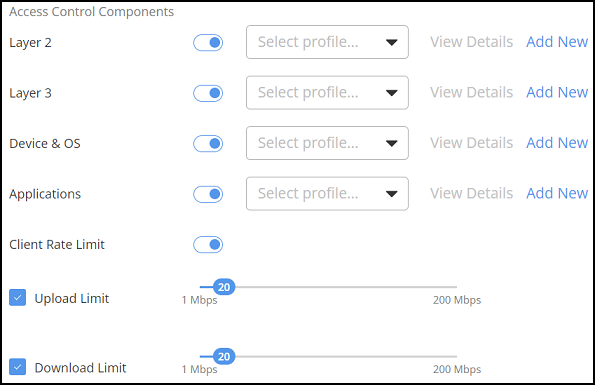
- Layer 2: Toggle the switch to ON and select the Layer 2 policy from the drop down list or click Add New to add a Layer 2 policy, refer to Step 3a.
- Layer 3: Toggle the switch to ON and select the Layer 3 policy from the drop down list or click Add New to add a Layer 3 policy, refer to Step 3b.
- Device & OS: Toggle the switch to ON and select the Device and OS policy from the drop down list or click Add New to add a Device and OS policy, refer to Step 3c.
- Applications: Toggle the switch to ON and select the Applications policy from the drop down list or click Add New to add an Applications policy, refer to Step 3d.
- Client Rate
Limit: Toggle the switch to ON and click to configure maximum upload rate
limit and maximum download rate limit using the slider.Note: Maximum client rate limit ranges from 1 Mbps to 200 Mbps.
-
Add a Layer 2
policy.
Layer 2 Settings Page 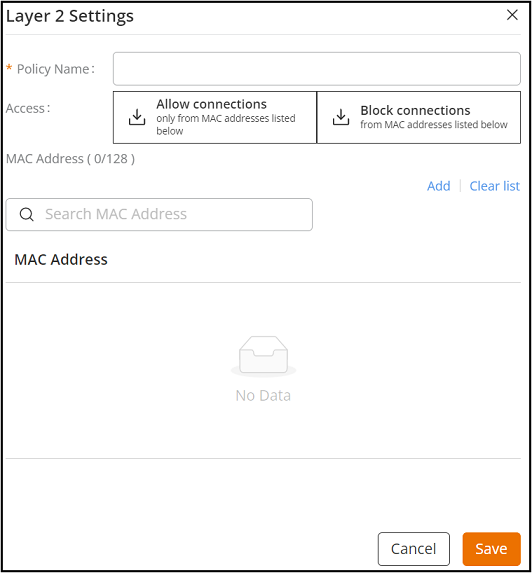
- In the
Layer 2 Settings page, complete the
following fields:
- Policy Name: Enter a name for the Layer 2 policy.
- Access: Select one of the following
options:
- Allow connections: This allows the user added MAC addresses to connect to the network server.
- Block connections: This deny the user added MAC addresses from connecting to the network server.
- Mac
Address: Select the MAC address from the
table or to add new MAC address, click Add. The Add MAC
address dialog box is displayed. Enter
the MAC address in the Add MAC
Address dialog box, and click Save.Note: You can add multiple MAC addresses at once by separating them with a comma or semicolon.Note: You can add up to 128 MAC addresses.
(Optional) click Clear list to clear the MAC address list.
- Click Save.
- In the
Layer 2 Settings page, complete the
following fields:
-
Add a Layer 3
policy.
Layer 3 Settings Page 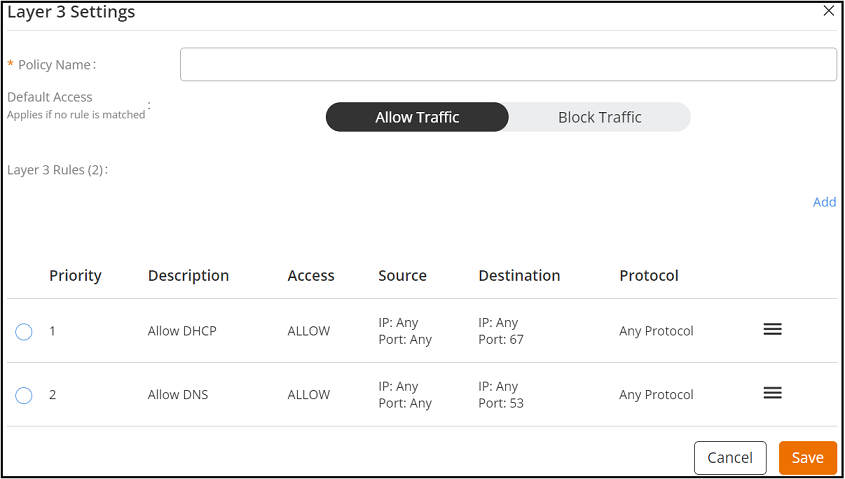
- In the
Layer 3 Settings page, complete the
following fields :
- Policy Name: Enter a name for the Layer 3 policy.
- Access: Select one of the following
options:
- Allow Traffic: This allows traffic to flow from a user added source to a destination IP address and port.
- Block Traffic: This deny traffic to flow from a user added source to a destination IP address and port.
- Layer
3 Rules: Select the rules from the table
or to add a new Layer 3 Rules, click Add. The Add Layer 3
Rule dialog box is displayed.
Add Layer 3 Rule Dialog Box 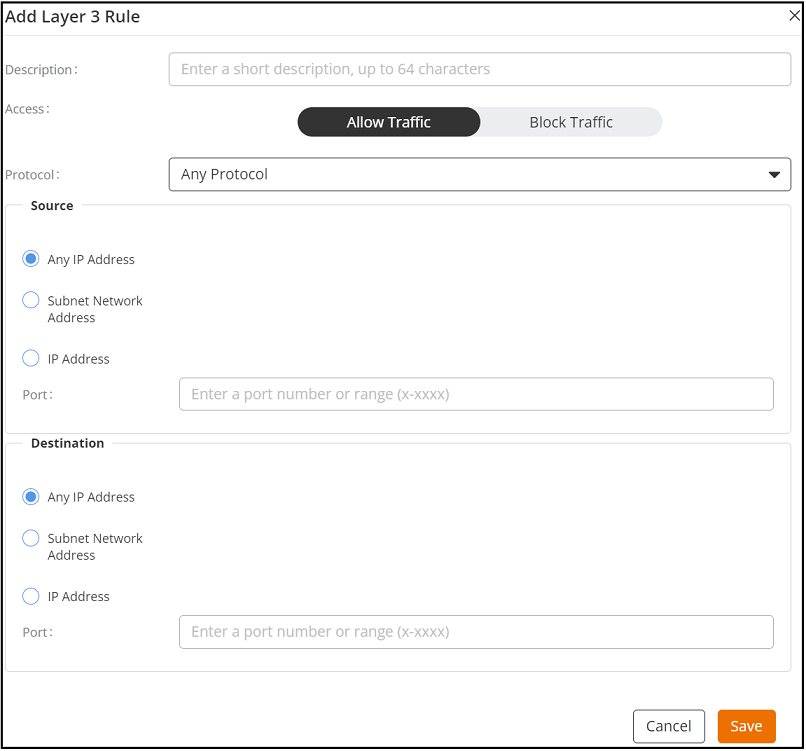
- Complete the following fields:
- Description: Enter a description for the rule.
- Access: Select one of the following
options:
- Allow Traffic: This allows the up-stream traffic.
- Block Traffic: This deny the up-stream traffic.
- Protocol: Select the protocol which
you wish to use for the new traffic rule, from the
Protocol drop down list. Following are the list of
protocols available for use.
- TCP: Transmission Control Protocol.
- UDP: User Datagram Protocol.
- UDPLITE: Lightweight User Datagram Protocol, which is a connectionless protocol that allows even a damaged data payload to be delivered rather than being discarded.
- ICMP (ICMPV4): Internet Control Message Protocol, which is an error-reporting protocol used by network devices to generate error messages to the source IP address, when issues in the network prevent delivery of IP packets.
- IGMP: Internet Group Management Protocol, which is a communications protocol used by hosts on IPv4 networks to establish multicast group memberships.
- ESP: Encapsulating Security Payload is a protocol which provides the authentication, integrity, and confidentially of network packets in IPv4 and IPv6 networks.
- AH: Authentication Header protocol, which is used to authenticate SNMP.
- SCTP: Stream Control Transmission Protocol is a communications protocol which operates at the transport layer.
- Source:
- Select one of the following options:
- Any IP Address: This allows or deny the up-stream traffic from any IP addresses.
- Subnet Network Address: Enter the source network address and source mask.
- IP Address: Enter the specific IP address.
- Port: Enter a port number or a range
of ports (for example, 22-34).Note:
If you select the ICMP protocol in the previous step, you do not need to specify ports for the source and the destination. Hence, the option to select ports will not be displayed.
- Select one of the following options:
- Destination:
- Select one of the following options:
- Any IP Address: This allows or deny the up-stream traffic from any IP addresses.
- Subnet Network Address: Enter the source network address and source mask.
- IP Address: Enter the specific IP address.
- Port: Enter a port number or a range
of ports (for example, 22-34).Note:
If you select the ICMP protocol in the previous step, you do not need to specify ports for the source and the destination. Hence, the option to select ports will not be displayed.
- Select one of the following options:
- Click Save.
- Complete the following fields:
- Click Save.
- In the
Layer 3 Settings page, complete the
following fields :
-
Add a Device and OS policy.
Access Control: Device & OS Access Settings Page 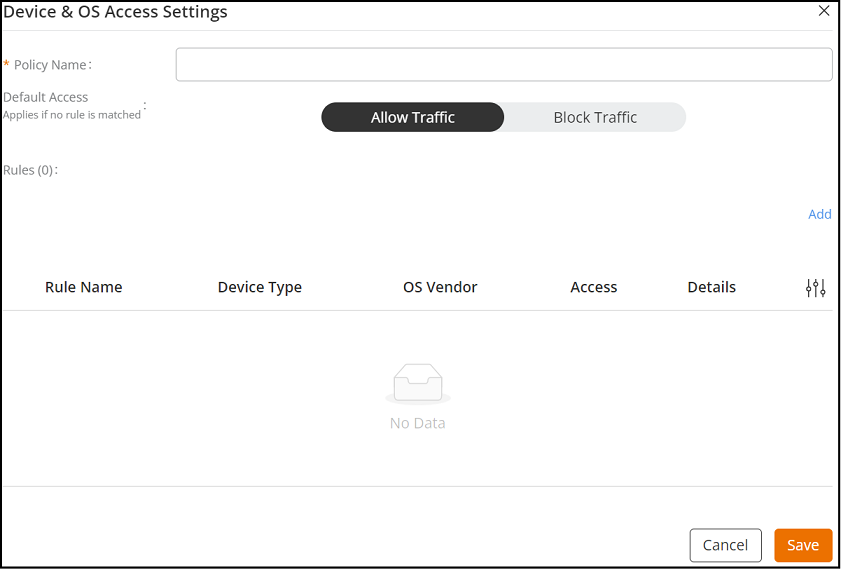
- In the
Device & OS Access Settings page,
complete the following fields:
- Policy Name: Enter the name of the policy.
- Default Access: Select one of the
following options:
- Allow Traffic: This allows traffic from the user added devices.
- Block Traffic: This deny traffic from the user added devices.
- Rules: Select the rules from the table
or to create a new rule, click Add. The Add Rule
dialog box is displayed.
Add Rule Dialog Box 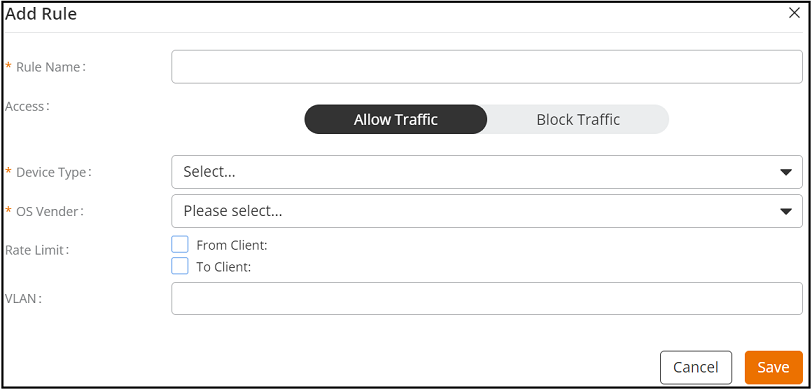
- Complete the following fields:
Adding a Device Policy Rule 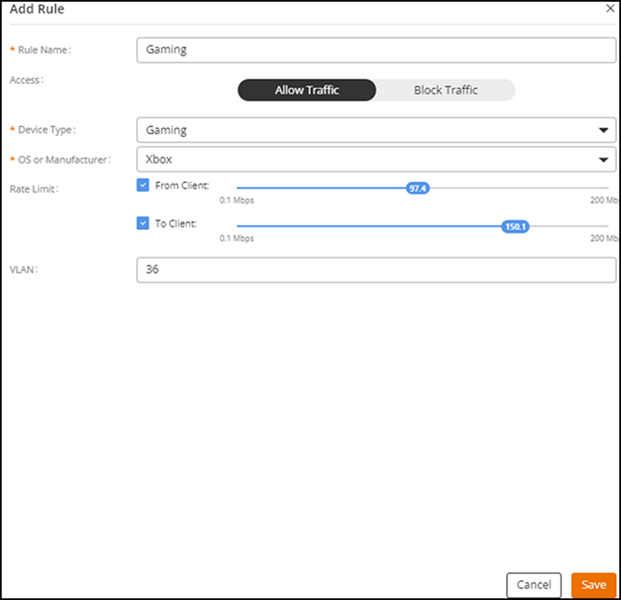
- Rule Name: Enter the name of the rule.
- Access: Select one of the following
options:
- Allow Traffic: This allows traffic from the devices.
- Block Traffic: This deny traffic from the devices.
- Device Type: Select a device type from the list of devices from the dropdown. Currently, the supported devices are, Laptop, Smart Phone, Tablet, VoIP, Gaming, Printer, and IoT device.
- OS
Vendor: Select the OS vendor for the
device from the dropdown.Note: The OS type field is populated based on the type of device. For example, if the device type is selected as Gaming, the OS or Manufacturer dropdown displays the following options: All, GameCube, Wii, PlayStation, Xbox, and Nitendo.
- Rate Limit: Configure the
From client and To
client rate limit using the
sliders.Note: Maximum rate limit ranges from 0.1 Mbps to 200 Mbps.
- VLAN: Enter the VLAN ID.
- Click Save.
- Complete the following fields:
- In the Device & OS Access Settings page, click Save.
- In the
Device & OS Access Settings page,
complete the following fields:
-
Add an Application
Access policy.
Access Control: Application Access Settings Page 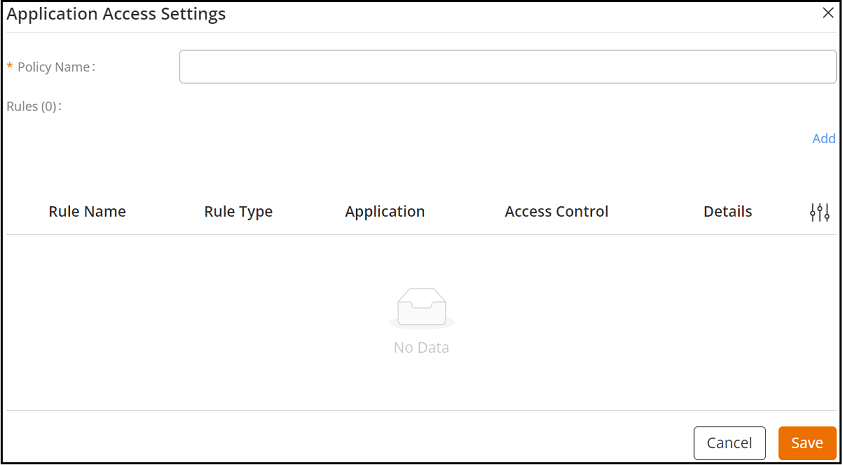
- In the
Application Access Settings page,
complete the following fields:
- Policy Name: Enter the name of the policy.
- Rules: Select the rules from the table
or to create a new rule, click Add. The Add Application
Rule dialog box is displayed.
Add Application Rule Dialog Box 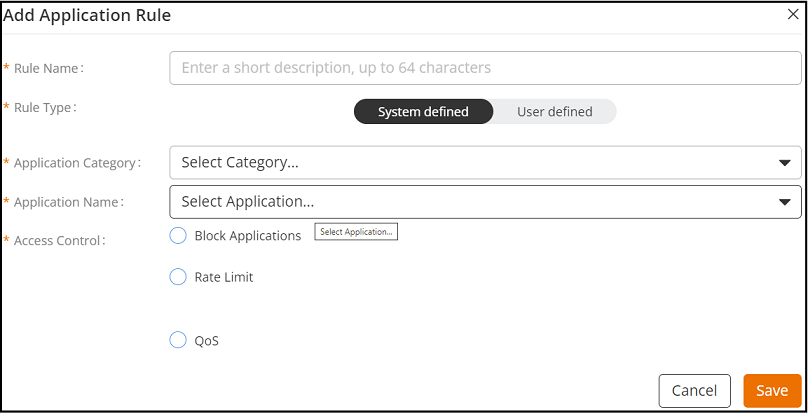
- Complete the following fields:
- Rule Name: Enter the name of the rule.
- Rule Type: Select one of the
following options:
- System Defined: Complete the
following fields.
- Application Category: Select the category of application from the list.
- Application Name: Enter the name of the application.
- User Defined: Complete the following
fields.
- Application Name: Enter the name of the application.
- Destination Ip: Enter the destination IP address.
- Netmask: Enter the subnet mask address.
- Destination Port: Enter the port number.
- Protocol: Select TCP or UDP.
- Port Mapping Only: Selecting this option disables the Destination Ip and Netmask fields.
- System Defined: Complete the
following fields.
- Access Control: Select one
of the following options:
- Block Application: This blocks the user added application.
- Rate Limit: Configure the
Max uplink rate and
Max downlink rate limits
using the sliders.Note: Maximum rate limit ranges from 0.25 Mbps to 20 Mbps.
- QoS: Complete the following fields.
- Uplink Marking: Select from
802.1p, DSCP, or Both, and select from Best effort, Video, Voice, or Background. By default, the
802.1p and Background is selected.
QoS: Uplink Marking 
- Downlink Priority: Select from Best effort, Video, Voice, or Background. By default, the Voice is selected.
- Uplink Marking: Select from
802.1p, DSCP, or Both, and select from Best effort, Video, Voice, or Background. By default, the
802.1p and Background is selected.
- Click Save.
- Complete the following fields:
- Click Save.
- In the
Application Access Settings page,
complete the following fields:
-
Click Finish.
An Access Control policy is created and is displayed in the Access Control page.